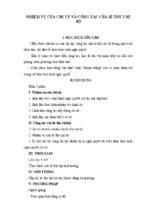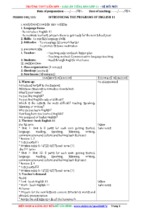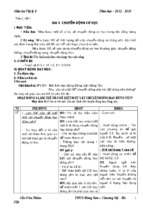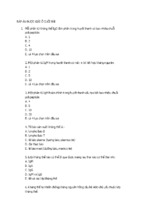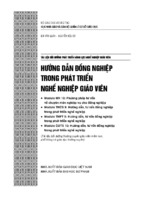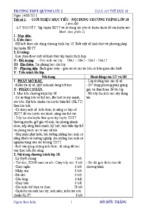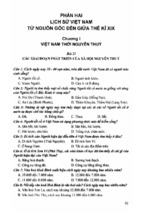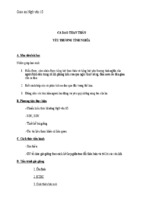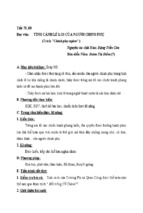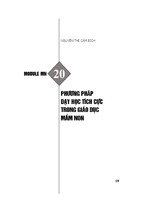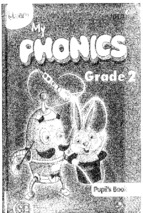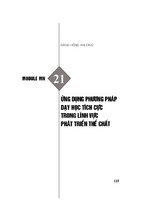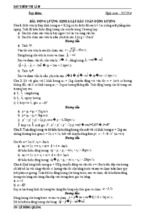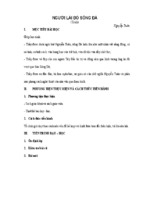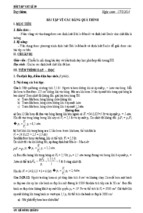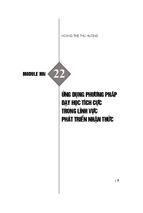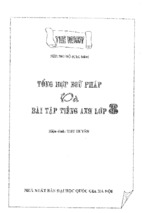Sở GD&ĐT Vĩnh Phúc – Trường THPT Liễn Sơn, TT Hoa Sơn, Lập Thạch, Vĩnh Phúc
TiÕt 1 + 2
Lesson 1 + 2: INTRODUCTION
Planning date:
Teaching date:
I. Objectives
1. Knowledge:
Student know: - How to learn English in grade 12
- How to do English tests
- How to use student’s book and workbook
2. Skills : have a right view about 4 skills:
- Reading
- Speaking
- Listening
- Writing
II. Teaching aids: Student’s book, student’s workbook.
III. Procedure:
Teacher’s activities
Students’ activities
Warm-up :(5 minutes)
- Introduce to students about the teacher
- Listen to the teacher
- Ask students about their names and English
- Answer the teacher’s questions
knowledge etc.
Guiding: (30 minutes)
1. Guiding student’s book and workbook:
* Introduce to students how to use their book and
workbook
* Introduce to students how to learn reading,
speaking, listening, writing, language focus in their
books and how to do the exercises in their books
2. Guiding English tests in grade 12:
* Introduce to students about oral tests, 15 minute
tests, 45 minute tests, etc. and how to do them
* The tests in grade 12 include:
reading : 25%
listening: 25%
writing: 25%
language focus: 25%
3. Guiding other books and tape, disc, etc.
Go through the textbook (8’)
Ask Ss to go through the textbook and analyze
according to the themes.
- put the student’s book and workbook
on the table
- listen to the teacher and look through
the books
- Listen to the teacher
Homework: 2 minutes
- Ask students to prepare textbook, notebooks and the
things for learning and prepare lesson reading - Unit
- listen to the teacher and write down
1
the things which will be prepared at
home
TiÕt 3
GV: ĐỖ VĂN BÌNH
Unit 1: home life
Unit 1 - Lesson 1: A. reading
1
GIÁO ÁN TIẾNG ANH KHỐI 12
Sở GD&ĐT Vĩnh Phúc – Trường THPT Liễn Sơn, TT Hoa Sơn, Lập Thạch, Vĩnh Phúc
Planning date: August 28th
Teaching date: September 1st
I. Aims: By the end of the lesson, students will be able to:
- understand more about home life
- develop reading skills: reading for main ideas and specific information, guessing the
meaning of the words
II. Language content: vocabulary about home life
III. Skills: Reading + Listening/Writing/Speaking
IV. Teaching aids: pictures, textbook, workbook, cards…
V. Procedure:
Teacher’s activities
Students’ activities
Warm up (5’)
- Write the sentence on the board:
“Men build the house and women make it home.”
- Give question:
What does the statement mean?
- Ask students to work in pairs to discuss the question.
- Collect students’ answers and give correct answer:
The statement means that men’s responsibility is to work
and support the family and women’s job is to look after
the family.
- Introduce the lesson:
Today we will understand more about the responsibility and
contribution of each member to have a happy family.
Pre – reading (7')
- Ask students to work in pairs, describe the picture.
- Give questions as cues:
1. Who do you think they are
2. Where is the family?
3. What is each member of the family doing?
4. Is the family happy? Why (not)?
- Ask students to answer
- Give feedback and suggested answers
1. parents and children
2. at home
3. The mother is helping the daughter with her study,
the father is playing with the son.
4. They are happy, because they love and support each
other.
- Introduce the reading text:
Now we will read a passage about a typical family to see
how they contribute to make their home life happy.
GV: ĐỖ VĂN BÌNH
2
Warm up (5’)
- Listen
- Discuss the question in pairs.
- Listen and write down
- Listen
Pre – reading (7')
- Work in pairs, look at the pictures in the
text book, and tell what these pictures are
about by answering the questions.
- Answer the questions
- Listen to the teacher
- Write down
- Listen
GIÁO ÁN TIẾNG ANH KHỐI 12
Sở GD&ĐT Vĩnh Phúc – Trường THPT Liễn Sơn, TT Hoa Sơn, Lập Thạch, Vĩnh Phúc
While reading (20')
- Ask students to read the passage silently to understand
the main ideas.
Task 1 (p14): Choose the sentence A, B or C that is
nearest in meaning to the sentence given.
- Ask students to do Task 1
- Ask students to compare the answers with a partner.
- Ask some students to read the answers
- Checks and gives correct answers:
1
2
3
4
5
B
C
A
B
A
While reading (20')
- Read the text silently once or two times.
Task 1 (p14):
- Work individually to do task 1
- Compare the answers
- Read aloud their answers
- Write down the correct answers
Task 2: Answer the questions
- Ask students to read the passage again and answer the
questions
- Ask students to compare the answers with a partner
- Checks and gives correct answers:
1. Very busy. They have to work long hours and
sometimes they have to work at night.
2. She is always the first one to get up in the morning to
make sure that her children leave home for school having
eaten breakfast and dressed in suitable clothes. She
always makes dinner ready before her husband comes
home.
3. The daughter helps with household chores: she washes
the dishes and takes out the garbage. She also looks after
the boys/ her younger brothers. The father sometimes
cooks/ does some cooking or mends things around the
house at weekends.
4. She attempts to win a place at university
5. Because they are very close-knit and supportive of one
another. They often share their feelings and whenever
problems come up, they discus them frankly and find
solutions quickly.
Task 2:
- Work in pairs to do the task
Post – reading (10')
- Ask students to work in groups, discuss the questions:
Compare the family in the text with your own family.
- Ask some students to present their discussion in front of
the class.
- Give feedback
Post – reading (10')
- Work in groups, discuss the questions
Homework (3')
- Summarize main points
Homework (3')
- Listen and note down
GV: ĐỖ VĂN BÌNH
3
- Compare the answers
- Read aloud their answers
- Write down the correct answers
- Report their discussion
- Listen
GIÁO ÁN TIẾNG ANH KHỐI 12
Sở GD&ĐT Vĩnh Phúc – Trường THPT Liễn Sơn, TT Hoa Sơn, Lập Thạch, Vĩnh Phúc
- Assign homework
TiÕt 4
Unit 1 - Lesson 2: B. speaking
Planning date: August 28th
Teaching date: September 3rd
I. Aims: By the end of the lesson, students will be able to:
- Understand more about home life, the relationship, responsibilities of family's members.
- Skills: discuss home life, the relationship and responsibilities of family's members.
II. Language content: vocabulary about home life
III. Skills: Speaking + Listening/Writing/Reading
IV. Teaching aids: pictures, textbook, workbook, cards…
V. Procedure:
Teacher’s activities
Students’ activities
Warm – up (5’)
- Give question:
o In your family, who often does housework?
o Is it fair or not?
- Lead to the lesson:
Today we will discuss the responsibility of each member in a
family in doing housework as well as supporting the family.
Pre – speaking (7')
Task 1: Read the following statements and tick the ones
that apply to you and your family.
- Ask students to read the statements and tick the ones that
apply to their families.
- Ask students to work in pairs, exchange the ideas.
- Ask some students talk about their families in front of the
class
- Give feedback
Warm – up (5’)
- Students’ answers may vary
- Listen
Pre – speaking (7')
Task 1:
- Listen and do the task
- Work in pairs
- Present in front of the class
- Listen
While speaking (20')
While speaking (20')
Task 2: Prepare a list of questions to ask another student Task 2:
to find out whether his/her family is like yours
- Ask students to prepare a list of questions to understand the - Do the task individually
family life, focusing on:
o who works in the family
o who does household chores
o responsibility in the family
o the interest the family members share closely
o the person you share secrets with
o the person you talk before making an important
decision.
- Give an example:
- Listen and write down
GV: ĐỖ VĂN BÌNH
4
GIÁO ÁN TIẾNG ANH KHỐI 12
Sở GD&ĐT Vĩnh Phúc – Trường THPT Liễn Sơn, TT Hoa Sơn, Lập Thạch, Vĩnh Phúc
Who works in your family?
Task 3: Ask your partner about his/her family life
- Ask students to use the questions to ask a partner about his/
her family life. Note down the answers.
Task 4: Tell each other the information you have collected
- Ask students to work in pairs to tell each other the
information collected
- Go around the class to check
- Give feedback
Task 3
- Do the task
- Note down the answers
Task 4
- Work in pairs to do the task.
- Listen
Post - speaking (10')
Post - speaking (10')
- Ask some students to present their collected information in - Present in front of the class
front of the class
- Give feedback
- Listen and note down
Homework (3')
- Summarize main points
- Assign homework
TiÕt 5
Homework (3')
- Listen and note down
Unit 1 - Lesson 3: C. listening
Planning date: September 1st
Teaching date: September 4th
I. Aims: By the end of the lesson, students will be able to:
- understand more about home life
- develop listening skills: listening for main ideas and specific information
II. Language content: vocabulary about home life
III. Skills: Listening + Reading/Writing/Speaking
IV. Teaching aids: cassette, pictures, textbook, workbook, cards…
V. Procedure:
Teacher’s activities
Students’ activities
Warm – up (5’)
Warm – up (5’)
- Ask students to work in pairs, look at and describe the - Describe the picture by answering
picture (p16), using the cues:
the questions
1. What is happening in the picture?
2. How many pictures are there?/ who are they?
3. How are they feeling? / How do they look?
- Call some students to answers
- Answer
- Give suggested answers:
- Listen and write down
1. A family is having a big meal.
2. There are 9 people.
3. They are very happy.
- Give feedback and introduce the topic of the lesson:
- Listen
Now we will listen to a conversation in a family reunion.
Pre – listening (7')
GV: ĐỖ VĂN BÌNH
Pre – listening (7')
5
GIÁO ÁN TIẾNG ANH KHỐI 12
Sở GD&ĐT Vĩnh Phúc – Trường THPT Liễn Sơn, TT Hoa Sơn, Lập Thạch, Vĩnh Phúc
- Play the tape, ask students to listen and repeat the words
flight
reserved
coach
rarely
close-knit spread out
leftovers crowded
- Correct students' pronunciation and explain the meaning of
the words
- Introduce the situation:
Listen to Paul and Andrea talking about their family life and
do the task below.
- Listen
- Repeat each of the words
While - listening(20')
Task 1: Decide whether the statements are True or False
- Ask students to read through the questions
- Play the tape two times
- Ask students to do Task 1 then compare the answer with a
partner.
- Play the tape again, have students listen and check the
answers
- Ask some students to read the answers
- Checks and gives correct answers:
While - listening (20')
Task 1:
1
2
3
4
5
F
F
F
T
T
Task 2: Note down two things that are different about Paul’s
and Andrea’s families.
- Ask students to read through the questions
- Play the tape two times
- Ask students to do Task 2 then compare the answer with a
partner.
- Play the tape again, have students listen and check the
answers
- Ask some students to read the answers
- Checks and gives correct answers:
Paul
Andrea
- Listen and note down
- Listen
- Read through the questions
- Work individually to do the task
- Compare the answers
- Listen again and check the answers
- Read aloud their answers
- Write down the correct answers
Task 2:
- Read through the questions
- Work individually to do the task
- Compare the answers
- Listen again and check the answers
- Read aloud their answers
- Write down the correct answers
His family members are not His family is a close - knit
very close.
one.
The family often eat the The family often go out to
meal the mother cooks at eat when they get together.
home.
Post – listening (10')
- Ask students to work in groups, discuss the questions:
Discuss the importance of family in a person's life
- Ask some students to present their discussion in front of the
GV: ĐỖ VĂN BÌNH
6
Post – listening (10')
- Work in groups, discuss the
questions
- Report their discussion
GIÁO ÁN TIẾNG ANH KHỐI 12
Sở GD&ĐT Vĩnh Phúc – Trường THPT Liễn Sơn, TT Hoa Sơn, Lập Thạch, Vĩnh Phúc
class.
- Give feedback
- Listen
Homework (3')
- Summarize main points
- Assign homework
TiÕt 6
Homework (3')
- Listen and note down
Unit 1 - Lesson 4: D. writing
Planning date: September 1st
Teaching date: September 8th
I. Aims: By the end of the lesson, students will be able to:
- understand more about home life
- develop writing skill: Writing about family rules
II. Language content: vocabulary about home life
III. Skills: Writing + Reading/Listening/Speaking
IV. Teaching aids: cassette, pictures, textbook, workbook, cards…
V. Procedure:
Teacher’s activities
Students’ activities
Warm – up (5’)
- Give question:
Do your family have any rules? What are they?
- Give feedback and lead to the lesson:
Today we will learn how to write about family rules.
Pre – writing (7')
Task 1: What rules do you have in your family?
- Have students revise the verbs
o let sb + V
o allow sb + to V
o have to + V (obligation)
o permit sb + to V
- Give example:
1. During the school year I'm not allowed to watch TV
until I have finished my homework.
2. In my family, everybody has to do their share of
household chores.
- Have the whole class brainstorm the rules of their
family. Write on the board
- Have students work in pairs to discuss the main ideas in
their writing, using the structures
o I have to .....
o My parents want me to....
o They allow me to ...
- Check and give feedback for the whole class.
GV: ĐỖ VĂN BÌNH
7
Warm – up (5’)
- Students’ answers may vary
- Listen
Pre – writing (7')
Task 1:
- Revise the knowledge
- Study the example
- Think of the family rules
- Discuss the main ideas
- Listen and note down
GIÁO ÁN TIẾNG ANH KHỐI 12
Sở GD&ĐT Vĩnh Phúc – Trường THPT Liễn Sơn, TT Hoa Sơn, Lập Thạch, Vĩnh Phúc
While- writing (20')
Task 2: Write a letter to a pen pal about your family
rules.
- Have students write a paragraph about their family rules,
begin as follows:
Every family has its own rules. Mine has a few. First,….
- Have students exchange their writings and find each
other’s mistakes
- Have students write the second draft
While - writing (20')
Task 2:
- Do the task
- Exchange and correct mistakes for their
partners
- Correct mistakes and write the second
draft
Post – writing (10')
Post – writing (10')
- Ask two students to write on the board
- Write on the board
- Correct mistakes and give feedback for the whole class
- Listen and note down
- Collect student’s papers, give comment and correct some
serious mistakes
- Listen and note down
Homework (3')
- Summarize main points
- Assign homework
TiÕt 7
Homework (3')
- Listen and note down
Unit 1 - Lesson 5: E. language focus
Planning date: September 4th
Teaching date: September 9th
I. Objectives:
1. Education aims: The ending ‘s’. Tenses revision.
2. Skills: Master the ending ‘s’ and tenses revision.
Know how to use tenses.
II. Anticipated problems:
+ Problems: Students may have difficulty in pronunciation.
+ Solutions: Explain carefully the ending ‘s’.
III. Teaching aids: board, chalk, textbook.
IV. Procedures:
Teacher's activities
Students' activities
1. Pronunciation:( 15 mins)
- Explain the way to use ending ‘s’- Help - Get the teacher’s explanation.
students to know the pronunciation.
+ /z/ follow voiced consonants except /z/, /dƷ/,
- Practice:
/ Ʒ /.
+ I saw some bats flying from the bags.
+ /s/ follow voiceless consonants except /s/,
+ He often speaks at different speeds.
/∫/, / t∫ /.
+ She tore the photographs in to halves.
+ /iz/ follow the ending sound of: /z/, /dƷ/, /Ʒ/,
+ I always have dates on rainy days.
/s/, /∫/, /t∫/.
+ The kids are playing with their toys kits.
- Practice reading in chorus or individually.
2. Grammar and vocabulary:( 28 mins)
- Explain once again the formations and the
usages of :
+ The past simple tense.
+ The past progressive tense.
+ The present perfect tense.
- Guide the students how to do the
GV: ĐỖ VĂN BÌNH
Exercise1:
1. Have you seen
2. Did you enjoy
3. was
4. Did you give…..saw
5. didn’t listen
6. Have you two met
8
GIÁO ÁN TIẾNG ANH KHỐI 12
Sở GD&ĐT Vĩnh Phúc – Trường THPT Liễn Sơn, TT Hoa Sơn, Lập Thạch, Vĩnh Phúc
-
exercises.
Divide the class into groups, ask them to
do the exercises.
Walk round to give help if necessary.
Correct the students’ work if necessary.
7. Did you meet
Exercise 2:
1. B
9. B
2. C
10. C
3. A
11. B
4. A
12. C
5. B
13. C
6. B
14. A
7. B
15. B
8. C
3. Homework: (1 min)
At home, revise the pronunciation, the tenses,
redo all the exercises and prepare unit 2.
TiÕt 8
UNIT 2: cultural diversity
Unit 2 - Lesson 1: A. READING
Planning date: September 6th
Teaching date: September 11th
I. Objectives:
1. Aims: - Students read and guess the meaning of words in contexts.
- They read and answer questions about the texts.
- They practice scanning for specific information in the texts.
2. Knowledge:
- General knowledge: the changes brought about by the economic reforms
- Language: + Words related to the topic (economic, medical and agricultural terms).
+ Common knowledge of education, healthcare, agriculture,…
II. Methods: integrated, mainly communicative.
III. Anticipated problems: no problems
IV. Teaching aids: picture, board, chalks, textbook, handouts,…
V. Procedures:
Teacher's activities
Students' activities
1. Warm- up:( 3 mins)
Aims: to introduce the topic of the lesson and to
raise students' interest.
- Tell the class the the differences between - now: beautiful buildings, good facilities,..
schools (hospitals, houses) now and the past ten - past: ….
years.
- How do farmers transport their farming - now: tractors, motorbikes, …
products now and how did they do ten years - past: human’s force or animal’s force.
ago?
- What make all of these changes?
- the development of economic.
2. Before you read:( 5 mins)
- Ask students (to work in pairs) to open their books, look at the pictures, and do the tasks that
follow.
+ What can you see..?
+ Do you think…?
+ What, in your opinion, should…?
- Ask them to work in 3 minutes, meanwhile T
moves round to help if necessary.
- Ask some pairs to report .
- Give some remark if necessary
GV: ĐỖ VĂN BÌNH
9
Things seen: a village, farmers, a buffalo,
some huts,…
A poor village, of course the farmers lead a
poor life.
Build a new road, change the cultivation
methods, …
GIÁO ÁN TIẾNG ANH KHỐI 12
Sở GD&ĐT Vĩnh Phúc – Trường THPT Liễn Sơn, TT Hoa Sơn, Lập Thạch, Vĩnh Phúc
3. While you read:( 25 mins)
+ Task 1:
- Ask students to read through the text once to
find out some new words, guess the main idea.
- Explain new words (give the Vietnamese
equivalents), guide the students to get the main
contents of the reading text.
- Ask students to work individually in 5 minutes
to do this task.
- Guide students to read through the passage ,
then focus on only the sentences surrounding the
suggested words to do the task effectively.
- Give students some more words that may be
new/ unfamiliar to them.
- Guide the students to read the word in chorus
and individually.
+ Task 2:
- Ask students to read the passage again and
choose whether the statements given are true (T)
or false (F).
- Ask them to work individually to do the task
and give the evidence to prove the keys.
- Move round to make sure that all students are
working and to help them if necessary.
- Ask some students to report and give
feedback.
+ Task 3:
- Ask students to read the passage again then
work in pairs to ask and answer the suggested
questions.
- Walk round the class to give help if necessary.
- Give suggested words, phrases or useful
GV: ĐỖ VĂN BÌNH
- Read through the text find the new words, try
to guess the meanings of those words in
contexts:
+ National Congresses: §¹i héi toµn quèc
+ renovation (n): ®æi míi
+ under-developed (pp):¸chËm ph¸t triÓn
+ inflation (n): l¹m ph¸t
+ stagnant (adj): tr× trÖ
+ government subsidies (n): sù bao cÊp cña
chÝnh phñ
+ government commitment (n): cam kÕt cña
chÝnh phñ
+ dissolve (v): tan r·
+ substantial (adj): lín lao, ®¸ng kÓ
- Get the meaning of some more words:
+ eliminate (v):….
+ intervention (n):…..
+ Vietnamese Communist Party
+ measure (n):……
+ promote (v):…..
+ economic reforms (n):…..
+ Land Law
+ Enterprise Law
- Work individually to read the text then choose
whether the statements given are true (T) or
false (F).
- Share the key with other students.
1. F
2. F
3. T
4. F
5. T
- Find in the text the evidence to prove the
keys.
- Do the task in pairs:
A: When and by whom was …?
B: in 1986 by the Vietnamese Communist Party
A: What was the aim…?
B: to restructure the economy of Vietnam, to
Raise the living standard of the people.
A: Name the renovation measures…?
B: eliminated government subsidies.
shifted economic priority…..of export.
reduced state intervention in business.
open trade relation…..the world.
encourage foreign……investment.
A: How has Vietnam changed…?
B: productivity and agricultural export…
farmers have enjoyed…..
workers have worked harder.
children, especially from …, … training.
A: What do we believe?
GIÁO ÁN TIẾNG ANH KHỐI 12
10
Sở GD&ĐT Vĩnh Phúc – Trường THPT Liễn Sơn, TT Hoa Sơn, Lập Thạch, Vĩnh Phúc
suggestions.
B: We believe that with the …..
- Correct the students’ work.
4. After you read:( 10 mins)
- Ask students to work in group to scan the text
again.
- Ask them to work in small groups of three or
four to talk about the text based on the
suggested points.
- Encourage them to use their own words.
- Ask one or two pairs to report.
VN before DM: economy under-developed
– country and poor people – production
stagnant – shortage of schools, hospitals –
inflation.
Renovation measures:
eliminated government subsidies - shifted
economic priority…..of export - reduced state
intervention in business open trade
relation…..the world - encourage foreign……
investment.
VN since DM: productivity and
agricultural
export
-farmers
have
enjoyed…..- workers have worked harder.
children, especially from …, … training.
5. Homework:( 1 min)
Write a passage to say what changes you’ve
seen in your village since the year 1986.
compare to the past.
TiÕt 9
Unit 2 - Lesson 2: B. speakING
Planning date: September 11th
Teaching date: September 15th
I. Objectives:
1. Aims: - Students work in pairs to describe the pictures.
- Students talk about measures and effects of the economic reforms in Fantasia.
2. Knowledge:
- General knowledge: economic reforms.
- Language: + Words related to economic reforms.
+ The way to make suggestions or predictions.
+ The tenses.
II. Methods: integrated, mainly communicative.
III. Anticipated problems:
- Problems: Students may face difficulty using economic terms .
- Solutions: teacher can give useful suggestions.
IV. Teaching aids: - picture, board, chalks, textbook, handouts
V. Procedures:
Teacher's activities
Students' activities
1. Warm-up:( 5 mins)
Tell a short story to prove that the renovation Listen and give one’s own ideas or story if
measures has apparently changed the social and being asked.
people’s lives positively.
2. Pre-speaking:( 9 mins)
+ Task1:
- Explain the requirements clearly in English
“in your textbook, there are four pictures. Now,
what I would like you to do is to look at them
carefully and say what they are about”
- Ask students to work in pairs to discus the
three questions and find the answers.
- Correct the students’s work and give remark.
GV: ĐỖ VĂN BÌNH
- Work in pairs to discus the three questions and
find the answers.
A: What does each pair of picture tell you?
B: It tells us the contrast between the present
and past situations.
A: What changes can you see in each pair of…?
B: The new school and factory are much bigger
GIÁO ÁN TIẾNG ANH KHỐI 12
11
Sở GD&ĐT Vĩnh Phúc – Trường THPT Liễn Sơn, TT Hoa Sơn, Lập Thạch, Vĩnh Phúc
and more beautiful than the old ones.
A: What do you think …..to achieve these…?
B: They must have taken some renovation
measures.
- Correct the answers oneself.
3. While-speaking:( 20 mins)
+ Task 2:
- Explain the requirements “The country of
Fantasia started its overall reforms…”.
- Divide the class into groups, asks each groups
to discus a section: Education
Health care
Agriculture
- Guide the students how to speak by giving
them useful suggestions:
+ They have………… so ……..
+ Due to the ………
+ Thanks to the………..
+ By applying……….
- Walk round from group to group to give help
if necessary.
- Encourage students to speak out what they
think even a phrase or a singular word.
Group 1: Education
S1: The government of Fantasia has changed
the curriculum and textbooks.
S2: They also provided schools with more
equipment and facilities.
S3: They build more schools and raised the
teachers’ salaries.
S1: It is obvious that they……
Group 2: Health care
S1: Many hospitals have been built as well as
the doctors’ and nurses’ salaries have been
raised.
S2: Due to the government’s policy, many more
highly qualified doctors have worked to
improve the people’s health.
Group 3: Agriculture
S1: Fantasia has applied appropriate policy to
encourage farmers to work more efficiently,
and they have built more dykes and damps,
irrigation and drainage systems.
S2: They’ve also applied new and advanced
farming techniques, more facilities and
equipment.
S3: They use fertilizers, pesticides and
insecticides to protect their crops.
4. Post-speaking:( 10 mins)
+ Task 3:
- Ask students to work individually to
summarize what they’ve discussed in their own
words.
- Move round to check the activities and to
make sure that students are working effectively.
- Ask one or two students to report in front of
the whole class.
- Check and give remarks.
S1: The government of Fantasia has changed
the curriculum and textbooks. They also
provided schools with more equipment and
facilities. They build more schools and raised
the teachers’ salaries…
S2: Fantasia has applied appropriate policy to
encourage farmers to work more efficiently,
and they have built more dykes and damps,
irrigation and drainage systems. They’ve also
applied new and advanced farming techniques,
5. Homework: ( 1 min)
more facilities and equipment. They use
Name some measures we’ve made to promote fertilizers, pesticides and insecticides to protect
our economic system.
their crops.
TiÕt 10
Unit 2 - Lesson 3: C. listenING
Planning date: September 11th
Teaching date: September 16th
I. Objectives:
1. Education aims: Students know the harm of taking drug.
2. Knowledge: a. General knowledge: Listen for specific information.
GV: ĐỖ VĂN BÌNH
12
GIÁO ÁN TIẾNG ANH KHỐI 12
Sở GD&ĐT Vĩnh Phúc – Trường THPT Liễn Sơn, TT Hoa Sơn, Lập Thạch, Vĩnh Phúc
b. Language:
- The present simple tense.
- Words related to the topic.
3. Skills: Listening comprehension.
II. Anticipated problems:
+ Problems:
- Students may do not know some works in the listening text.
- They do not know where to focus on the listening text.
+ Solutions:
- Teach new words in advance.
- Guide students to guess the answers before they listen.
III. Teaching aids: Tape, board, chalk, textbook.
IV. Procedures:
Teacher’s activities
Students’ activities
1. Warm up:( 5 mins)
A story about an addict.
2. Before you listen:( 10 mins)
- Ask students to work in pairs to ask and answer - Work in pairs:
the given questions.
S1: Should drug-taking be banned?
- Guide the students to answer if necessary.
S2: Yes, because it brings the users many
- Give further information.
harm on not only their physical but also
mental health.
S1: Drug-taking is totally a social evil.
- Explain the words that will appear in the - Listen and repeat:
listening text.
Tango
discourage
- Ask students to read in chorus then individually. Drug-taker
rationally
Ruin
solution
Unfortunately
measures
islanders
3. While you listen:( 20 mins)
+ Task 1:
- Ask students to read the statement at least - Read the statement once to get the main
once first.
contents.
- Ask them to guess the answers
- Listen to the tape and do the task.
- Play the tape once then check how many - Find evidences to each of the answers.
answers can students find.
- Represent if being asked.
- Play the tape again.
Keys: 1. F
2.F
3. T
- Check and give remarks.
4. T
5. F
6. F
- Call some students to say out their answers
7. T
8. T
9. F
and the evidences they get to prove their Listen to the teacher’s explanation then
answers.
correct the answers oneself.
+ Task 2:
- Ask students to read the questions.
- Ask them to guess the answers.
- Play the tape once then check how many
answers can students find.
- Play the tape again.
- Check and give remarks.
Call some students to say out their answers
and the evidences they get to prove their answers
4. After you listen:( 9 mins)
- In group, ask students to discus the guided
question, find the answer.
GV: ĐỖ VĂN BÌNH
-
Read the questions once to get the main
contents.
- Listen to the tape and do the task.
- Find evidences to each of the answers.
- Represent if being asked.
1. They discovered a plant containing a
powerful drug.
2. They grew it all over the island.
3. The negative effects: people become lazy
– children did not go to school – the
shortage of food.
4. Measures: introduced a law to make the
13
GIÁO ÁN TIẾNG ANH KHỐI 12
Sở GD&ĐT Vĩnh Phúc – Trường THPT Liễn Sơn, TT Hoa Sơn, Lập Thạch, Vĩnh Phúc
- Move around to help if necessary.
- Give remarks or even suggestions.
drug illegal – put drug-takers into prison –
export the drug to other countries.
Listen to the teacher’s explanation then
correct the answers oneself.
- In groups, ask and answer the question.
S1: Do you think that the Government of
Tango……?
S2: I don’t agree with that solution because
when they export the drug to other
countries the other peoples will suffer from
5. Homework: ( 1min)
the drug-taking problems, and other
Imagine you are an MP of Tango what would government will face the same problems as
you do to solve the problem.
theirs.
Listen to the teacher’s guide to correct
oneself.
TiÕt 11
Unit 2 - Lesson 4: D. writING
Planning date: September 16th
Teaching date: September 18th
I. Objectives:
1. Education aims: Students write a report.
2. Knowledge: a. General knowledge: Writing a report on the economic development.
b. Language: +The tenses.
+ Connectors (time expressions)
3. Skills:
Writing a report.
II. Anticipated problems:
+ Problems: Students may not know new words and the structure.
+ Solutions: Explain these words/ structures in advance.
III. Teaching aids: A picture, board, chalk, textbook.
IV. Procedures:
Teacher's activities
Students' activities
1. Warm- up:( 5 mins)
Free talk about the changes in one’s home Do as required.
village during the renovation process.
Exchange the ideas with others.
2. Before you write:( 15 mins)
- Explain as clearly as possible the - Listen to the teacher.
requirements “The table below presents the - Get the task.
results the Government…..”.
- Give clear task to students.
+ Task 1:
- Work in pairs to do the task.
- Ask students to look at Task 1.
S1: What was the economic situation in Tango
- In pairs, ask students to ask and answer before 1980?
the questions.
S2: It was really bad. The country was under- Move around to give help.
developed.
- Check and give remarks.
S1: What can you say about the economic
situation in Tango from 1980 to 200?
S2: Many positive changes has made. The
economic situation in 2000 is much better than
the one in 1980.
S1: What do you think the ….?
S: They have taken positive measures….
- Listen to the teacher to correct oneself.
3. While you write:( 15 mins)
GV: ĐỖ VĂN BÌNH
GIÁO ÁN TIẾNG ANH KHỐI 12
14
Sở GD&ĐT Vĩnh Phúc – Trường THPT Liễn Sơn, TT Hoa Sơn, Lập Thạch, Vĩnh Phúc
+ Task 2:
- Explain the requirements: Writing a report
+ The economic situation of Tango before
1980.
+ The measures taken by the Government and
the people of Tango overcome the problems.
+ The achievement ( as presented in the table)
they have made as a result of the reform.
- Ask students to work in groups to write
report.
- Walk round to give help if necessary.
- Work in groups to do the task.
The Government and the people of Tango
started their overall economic reform in the
mid 1970s. Before that time the economy of the
country was in ruins………. . The Government
of Tango has taken a lot of measures in order
to promote the national economy such as……. .
Despite all difficulties, the people of Tango
….. . After all, they have received greater and
greater achievements….
- Compare the result to the other groups.
- Listen to the teacher’s explanations.
- Exchange the writing to other groups to
check and give remarks.
4. After you write:(9 mins)
- Ask some groups to represent their work,
ask other to give remark.
- Choose some good writing to read in class
and give remark.
- Represent the task on board if being asked.
- Read the writing to get others’ remarks.
The Government and the people of Tango
started their overall economic reform in the
mid 1970s. Before that time the economy of the
country was in ruins………. . The Government
of Tango has taken a lot of measures in order
to promote the national economy such as……. .
Despite all difficulties, the people of Tango .. .
After all, they have received greater and
greater achievements….
-
Do as the teacher asked.
5. Homework( 1min)
Rewrite the task at home.
TiÕt 12
Unit 2 - Lesson 5: E. language focus
Planning date: September 17th
Teaching date: September 22nd
I. Objectives:
1. Education aims: Strong form and weak form of auxiliaries; adverbial clauses.
2. Skills: Master the strong form and weak form of auxiliaries.
Know how to use and make adverbial clauses of concession.
II. Anticipated problems:
+ Problems: Students may have difficulty in pronunciation.
+ Solutions: Explain carefully the strong form and weak form of auxiliaries.
III. Teaching aids: board, chalk, textbook.
IV. Procedures:
Teacher's activities
Students' activities
1. Pronunciation:( 15 mins)
- Explain the way to use strong form - Get the teacher’s explanation.
(emphasis, positive, stressed cases ), weak Can /kæn/ (str)
/kәn/ (w)
form (interrogative, unstressed cases)
Could /kud/
- Help students to know the pronunciation.
Must /m st/ (str)
/mәst/
- Practice:
Have /hæv/
A: Can you speak English?
Has /hæs/
B: Yes, I can.
Do /du/
A: Must we go now?
Does /d z/
B: I think we must.
Is /iz/
GV: ĐỖ VĂN BÌNH
GIÁO ÁN TIẾNG ANH KHỐI 12
15
Sở GD&ĐT Vĩnh Phúc – Trường THPT Liễn Sơn, TT Hoa Sơn, Lập Thạch, Vĩnh Phúc
A: Have you met Quang?
B: Yes, I have
A: Has she gone?
B: Yes, she has.
A: Shall we go now?
B: I think we ought to.
A: Will you come tomorrow?
B: Yes, I will.
A: Do you really have time for it?
B: Yes, I do.
2. Grammar and vocabulary:( 28 mins)
- Explain once again the “Clause of
concession”.
Though
Although
S + V, S + V
Even though
- Guide the students how to do the
exercises.
- Divide the class into groups, ask them to
do the exercises.
- Walk round to give help if necessary.
- Correct the students’ work if necessary.
Am /æm/
Will /wil/
Shall /sæl/
- Practice reading in chorus or individually.
Exercise1:
1. Although it rained a lot, we enjoyed our
vacation.
2. Although we had planned everything
carefully, a lot of things went wrong.
3. Even though/ Although the doctor has
advised him to quit, Bob (still)….
4. Although it was cold and rainy, we
managed to go to class in time.
5. Although Luong has studied English only
for six months, he can …….
6. I didn’t go to bed early although I was …
Exercise 2:
1. Although I was very tired
2. Although I had never seen her before
3. although it was pretty cold
4. although we don’t like them very much
5. Although I didn’t speak the language
6. Although the heat was on
7. although I’d met her twice before
8. although we have known ……..
Exercise 2:
9. we forget many things
10. they were very happy
11. he could speak/ read the language…
12. Although he had revised everything…
13. it is pretty cold/ there hasn’t been….
3. Homework: (1 min)
At home, revise the strong form and weak
form of auxiliaries, the use of clause of
concession, redo all the exercises and prepare
unit 8.
TiÕt 13
Unit 3: Ways of socializing
Unit 3 - Lesson 1 : A. reading
Planning date: September 17th
Teaching date: September 29th
I. Objectives:
1. The aim:
After the lesson, students are able to know how to communicate politely , some new words
related communication.
2. Lexical items:
GV: ĐỖ VĂN BÌNH
GIÁO ÁN TIẾNG ANH KHỐI 12
16
Sở GD&ĐT Vĩnh Phúc – Trường THPT Liễn Sơn, TT Hoa Sơn, Lập Thạch, Vĩnh Phúc
Words related to ways of socializing
3.Teaching aids: cassette, tape, picture
4.Skills: reading for gist
II. Method: Intergraded, mainly communicative
III. Procedure
Teacher’s activities
Students’ activities
I. Warm-up
Questions:
Ts asks students to look at the picture in their
1. What are the people in the pictures
book carefully and answer the questions
doing?
2. What will you do if you want to ask your
teacher a question , but he is talking to
your classmate?
II. Pre-reading
A
Matching the words
1. non-verbal
Asks students to match these words
2. verbal
3. impolite
4. attract someone’s attention
Read these words & pronounce them
5. rude
B
a. Kh«ng lÞch sù
b. thu hót sù chó ý cña ai
c. b»ng lêi, h÷u ng«n
d. th« tôc, th« b¹o
e. kh«ng b»ng lêi, phi ng«n
eg.
a slight nod will do
formal (a ) formality (n)
listen
to
the
passage
Teacher gives some more new words if
necessary
Task 3.
Read the passage by skimming skill
T plays the tape once
Answer the questions in the book.
III. While reading
practice
Task3.
Suggested answers:
T asks students to read the questions
1. ...we can use both verbal and non-verbal
carefully
communication.
Pay attention to key words
2. They are strong actions that can easily be
seen.
Like: What... do... to attract someone’s
3.
....we can wait until he passes near us,
attention.....
catch his eyes, nod slightly to let him
Asks them to work in pairs
know we would like him to come to our
table. Or we can raise your hand slightly
to show that we need assistance.
4. ........you can use a small friendly wave to
attract his or her attention.
let them practice
5. Because pointing at someone is usually
considered rude
give feedback
Task 2.
Which options is the best tile for the passage
Task 2.
A.. Attracting Attention: Non-verbal Cues
Ask students to work in groups
Call on some groups to answer the question.
GV: ĐỖ VĂN BÌNH
Discuss the meaning of whishing and handclapping in Vietnamese culture.
17
GIÁO ÁN TIẾNG ANH KHỐI 12
Sở GD&ĐT Vĩnh Phúc – Trường THPT Liễn Sơn, TT Hoa Sơn, Lập Thạch, Vĩnh Phúc
Post reading
Asks students to work in groups
Encourage – despise
Homework
Write a passage to tell about one of your most
embarrassing experiences
TiÕt 14
Unit 3 - Lesson 2: B. Speaking
Planning date: September 27th
Teaching date: September 30th
I. Objectives:
1. Aims: students should know how to give and respond to compliments in different situations.
2. Skills: fluency in talking about compliments
II. Method:
Integrated, mainly communicative
III. Teaching aids text books
IV. Procedure
Teacher’s activities
Students’ activities
Warm up
Warm up
Require students to list adjectives , Beautiful (ly)
adverbs which are often used when people nice
give and respond to compliment
wonderful
terrific
good/well/better
Introduce the title of the lesson
thank..........
Pre-speaking
Pre-speaking
Task 1.
Task 1.
Ask students to work in pair to practice Practice reading and pay attention how people
reading the dialogues, paying attention to give and respond to compliments
how people give and respond to
compliments in each situation.
Explain some new words if necessary
While – speaking
Task 2
Explain the task requirement.
Ask students to practice speaking
Go around and help students if necessary
Ask some students to speak in front of the
class.
Correct their answers
Task 3.
Explains the task requirement
Ask students to practice responding
compliments.
Help students if necessary
Ask some students to speak in front of the
class.
Correct their answers
GV: ĐỖ VĂN BÌNH
While – speaking
Task 2
Practice giving compliments to suit the
responses.
Suggested answers
David: What a beautiful dress you are wearing,
Kathy.
Hung: You have a decent motorbike, Hien.
Michael: You played badminton very well today,
Colin.
Task 3:
practice responding compliments
Suggested answer
You: Thank, Phil . I think that’s because I have
practiced a lot with the help of my dancing
teacher
You: I’m glad you like listening to me playing
the guitar.
You: That’s kind of you to say so, Tom.
GIÁO ÁN TIẾNG ANH KHỐI 12
18
Sở GD&ĐT Vĩnh Phúc – Trường THPT Liễn Sơn, TT Hoa Sơn, Lập Thạch, Vĩnh Phúc
Actually, my English is influenced by an
American teacher.
Post- speaking
Post- speaking
Task 4.
Task4.
practice giving and responding to compliments
Explain the task requirement
Suggested answers:
Ask students to practice in pairs( each The pair of glasses you are wearing are so nice,
pair can choose two situations to speak)
Lan.
Ask students to speak in front of the class. Thanks, Nga. My friend gave them to me on my
birthday.
What a new and expensive watch you have , Tam
I’m glad you like it. I bought it yesterday.
V. Homework
Practice giving and responding to compliments
for the situations of task 4 again.
TiÕt 15
Unit 3 - Lesson 3: C. Listening
Planning date: October 1st
Teaching date: October 2nd
1. Objectives: After the lesson students will be able to improve such listening skills as listening for
gist and listening for specific information by doing true/ false and gap-filling exercises.
2. Time: 45 minutes
3. Teaching aids: textbook, cassette player, tape, blackboard.
4. Procedure:
Time
Teacher’s activities
Students’ activities
(10ms)
*Before you listen:
+ Activities 1: work with a partner:
-ask Ss to work in pairs to study the pictures
-look at picture and answer questions
and answer the questions in textbook:
1.What are they doing?
2. What do you think each of them would say
to each other?
3. What do you think they would talk about?
4. How long do you think it would take them to
finish their call and why?
- call on some Ss to present their answers
( these questions require open answers)
-present their answers
+ Activities 2: listen and repeat
-teach Ss the pronunciation and meaning of
some key words:
-take notes new words
Marvelous (a): = great.
Arguments (n) = disagreement
Regulations (n) = rules
Object (v) = not allow somebody to do
something.
Startling (a) = make somebody shocked
-ask Ss to listen to the tape and repeat these
words.
-listen and repeat words
- call on some Ss to read aloud these words.
-read aloud these words
- introduce listening passage: a social worker
will advises young people on how to use the
telephone in their family.
*While you listen:
-read the statements and guess the
+Task 1:
answers
GV: ĐỖ VĂN BÌNH
GIÁO ÁN TIẾNG ANH KHỐI 12
19
Sở GD&ĐT Vĩnh Phúc – Trường THPT Liễn Sơn, TT Hoa Sơn, Lập Thạch, Vĩnh Phúc
-explain task requirements
(13ms) - ask Ss to read through all the statements to
find out what they might hear.
- ask Ss to guess the answers in pairs.
- play the tape twice.
- asks Ss to compare answers in pairs.
- ask Ss to present answers and check them.
1.T
2.F
3.T
4.F
5.F
6.T
+Task 2:
-ask Ss to read through the passages to guess
the missing words.
(12ms) - play the tape once or twice.
- ask Ss to compare answers in pairs
- play the tape for Ss to check their answers
- call on some Ss to present answers on board.
- check Ss’ answers:
1.agreed
5.waking
2.to avoid
6.heart
3.particular
7.kindness
4.adults
8.to stick
*After you listen:
-ask Ss to work in groups to summarize the
talk, basing on some main points:
(7ms) Length of time for each call
Time for calling
Calling late at night
Calling at weekend
-call on some Ss to present their ideas orally.
(3ms)
*Homework: ask Ss to take notes some ways
to give advice on something.
TiÕt 16
-listen to the tape
-compare answers in pairs and
presents
-read and guess missing words
-listen to the tape
-compare answers and present
answers.
-work in groups to summarize the talk.
-present their ideas.
-take notes homework.
Unit 3 - Lesson 4: D. WRITING
Planning date: October 3rd
Teaching date: October 6th
I. Objectives:
1. Aims: After the lesson, the students should be able to:
+ build complete sentences from the given words.
+ put the jumbled sentences in their correct order and write the complete paragraphs.
2. Knowledge:
- General knowledge : Ways of socializing
- Language: + Words concerning apologies.
+ The present simple tense.
II. Methods: integrated, mainly communicative.
III. Teaching aids: textbook, handouts
IV. Procedures:
Teacher's activities
Students' activities
1. Warm- up:( 5 mins)
1. Warm- up:( 5 mins)
- Ask students to close their books
- Deliver handouts, and ask students to match - close their books
the words in column A with its suitable meaning - match two columns
in column B.
- work in groups
A
B
Answer keys:
1. observe
a. tạm biệt
1- e
GV: ĐỖ VĂN BÌNH
GIÁO ÁN TIẾNG ANH KHỐI 12
20
- Xem thêm -

